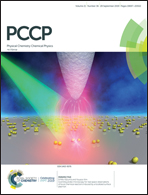Methylthio BODIPY as a standard triplet photosensitizer for singlet oxygen production: a photophysical study†
Abstract
A complete photophysical study on the iodinated-BODIPY, 3,5-dimethyl-2,6-diiodo-8-thiomethyl-pyrromethene (MeSBDP), demonstrated that it is an excellent triplet photosensitizer for singlet oxygen production in a broad range of apolar and polar solvents. Besides its absorption and fluorescence emission spectra, the dynamics of its excited states including its intersystem crossing rate was characterized by femtosecond transient experiments. The photophysical study of its triplet state by nanosecond transient absorption spectroscopy and phosphorescence emission concluded to a diffusion-controlled quenching of 3MeSBDP by O2 and to a fraction of triplet state quenching by O2 close to unity. The high (>0.87) and solvent-insensitive singlet oxygen quantum yield ϕΔ measured by singlet oxygen phosphorescence emission, together with the noticeable photostability of MeSBSP, as well as the absence of quenching of singlet oxygen by MeSBDP itself, allows claiming it as an alternative standard photosensitizer for singlet oxygen production, under excitation either in the UV or in the visible range.
close to unity. The high (>0.87) and solvent-insensitive singlet oxygen quantum yield ϕΔ measured by singlet oxygen phosphorescence emission, together with the noticeable photostability of MeSBSP, as well as the absence of quenching of singlet oxygen by MeSBDP itself, allows claiming it as an alternative standard photosensitizer for singlet oxygen production, under excitation either in the UV or in the visible range.



 Please wait while we load your content...
Please wait while we load your content...